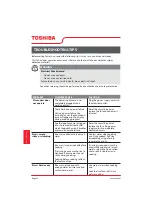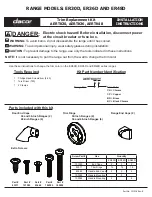
T
roubleshooting
TROUBLESHOOTING TIPS
Before calling for service, review the following tips. It may save you time and money.
This list includes common occurrences that are not the result of poor workmanship or
defective materials.
Any other servicing should be performed by an authorized service representative.
WARNING
Electrical Shock Hazard
• Do not use an adapter.
• Do not use an extension cord.
Failure to do so can result in death, fire or electrical shock.
PROBLEM SOLUTION
POSSIBLE CAUSE
Rice cooker does
not operate
Rice is mushy,
sticky or clumping
Rice is hard or dry
The power supply cord is not
completely plugged into a
working outlet.
Plug the power supply cord into
the electrical outlet.
There has been a power failure.
During a power failure, the
time-of-day, not the countdown
time, will appear in the display
during a cooking program.
Another appliance was plugged
into the same electrical outlet,
which tripped the circuit breaker
or blown a household fuse.
Rice was cooked with too much
water
Rice was rinsed or soaked before
cooking
Pre-rinsing can cause the rice to
crack and become mushy and
sticky during cooking.
Soaking before cooking softens
the texture of rice.
Rice was not cooked with
enough water or it was cooked
with mineral water.
Reset the circuit breaker or
replace the fuse once power is
restored.
Reset the circuit breaker or
replace the fuse. Plug power
supply cord into a separate,
dedicated circuit.
Use less water when cooking
rice. Once cooked, fluff rice
immediately using a fork to
separate the grains.
If rinsing is required, rinse the
rice quickly and drain as much
water as possible. Do not allow
rice to soak in liquid prior to
cooking.
Use more water when cooking
rice.
Soak the rice for a short time
before cooking.
Page 20
User Manual
T
roubleshooting







































